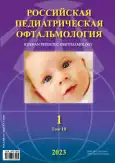Value of optical coherence tomography angiography for the assessment of visual functions in children with retinopathy of prematurity
- Authors: Katargina L.A.1, Kogoleva L.V.1, Osipova N.A.1, Kokoeva N.S.1
-
Affiliations:
- Helmholtz National Medical Research Center of Eye Diseases
- Issue: Vol 18, No 1 (2023)
- Pages: 13-20
- Section: Original study article
- URL: https://journal-vniispk.ru/1993-1859/article/view/131778
- DOI: https://doi.org/10.17816/rpoj112251
- ID: 131778
Cite item
Abstract
AIM: To compare and assess morphometric, structural, and microvascular parameters of the macular zone in children with cicatricial ROP grades I–III with different visual acuity from those in healthy peers.
MATERIAL AND METHODS: Eighteen children (36 eyes) aged 8–18 years with cicatricial ROP grades I–III were examined. Ten peers (20 eyes) made up the control group. All children, in addition to the standard ophthalmological examination, underwent optical coherence tomography and optical coherence tomography with angiography (OCTA). The diagnosis was carried out on a tomograph RS-3000 Advance 2 (Nidek (Japan)). In the resulting 3×3 mm scans with a center in the fovea, the vascular and perfusion density of the superficial retinal capillary plexus (SCP), deep retinal capillary plexus (DSP), and the foveolar avascular zone, were measured, the thickness of the retina in the fovea was evaluated, and the structure of the neuroepithelium in the macula was assessed.
RESULTS: In children born before 27 weeks, the central retinal thickness was higher than that in more “mature” children (231.8±18.2 and 208.2±15.2 mµ, respectively), and the relationship of this parameter with visual acuity was not explored. The vascular density of SCP in children with ROP and best-corrected visual acuity (BCVA) up to 0.4 and more than 0.4 were 1.46 mm-1 and 1.35 mm-1, respectively; and in the control group, it was 1.89 mm-1.
The perfusion densities of the SCP in these groups were 9.2%, 10.03%, and 13.3%, respectively. The vascular densities of the Deep capillary plexus (DCP) in children with ROP with BCVA up to 0.4 and more than 0.4 were 2.8 mm-1 and 3.0 mm-1, respectively; in the control group, it was 3.2 mm-1, and the perfusion density of the deep capillary plexus (DCP) in indicated groups were 25.7%, 30.9%, and 31.7%, respectively.
CONCLUSION: The analysis of the architectonics of the retinal vascular bed in children with ROP using OCTA makes it possible to assess the relationship between microcirculation disorders in the central zone of the retina and visual acuity, which is of great scientific and practical importance.
Full Text
##article.viewOnOriginalSite##About the authors
Lyudmila A. Katargina
Helmholtz National Medical Research Center of Eye Diseases
Email: katargina@igb.ru
ORCID iD: 0000-0002-4857-0374
MD, Dr. Sci. (Med.), Professor
Russian Federation, MoscowLyudmila V. Kogoleva
Helmholtz National Medical Research Center of Eye Diseases
Email: kogoleva@mail.ru
ORCID iD: 0000-0002-2768-0443
MD, Dr. Sci. (Med.)
Russian Federation, MoscowNatalya A. Osipova
Helmholtz National Medical Research Center of Eye Diseases
Author for correspondence.
Email: natashamma@mail.ru
ORCID iD: 0000-0002-3151-6910
SPIN-code: 5872-6819
MD, Cand. Sci. (Med.)
Russian Federation, MoscowNina Sh. Kokoeva
Helmholtz National Medical Research Center of Eye Diseases
Email: ninoofta@mail.ru
ORCID iD: 0000-0003-2927-4446
ophthalmologist
Russian Federation, MoscowReferences
- Samara WA, Say EA, Khoo CNL, et al. Correlation of foveal avascular zone size with foveal morphology in normal eyes using optical coherence tomography angiography. Retina. 2015;35(11):2188–2195. doi: 10.1097/IAE.0000000000000847
- Mintz-Hittner HA, Knight-Nanan DM, Satriano DR, Kretzer FL. A small foveal avascular zone may be an historic mark of prematurity. Ophthalmology. 1999;106(7):1409–1413. doi: 10.1016/S0161-6420(99)00732-0
- Tereshchenko AV, Trifanenkova IG, Panamareva SV. Optical Coherence Tomography-Angiography in Pediatric Ophthalmological Practice (Review). Ophthalmology in Russia. 2021;18(1):5–11. (In Russ). doi: 10.18008/1816-5095-2021-1-5-11
- Kogoleva LV. Clinical and functional eye’s parameters in extremely low birth weight patients with retinopathy of prematurity. Russian Pediatric Ophthalmology. 2014;9(3):14–19. (In Russ). doi: 10.17816/rpoj37594
- Falavarjani KG, Iafe NA, Velez FG, et al. Optical coherence tomography angiography of the fovea in children born preterm. Retina. 2017;37(12):2289–2294. doi: 10.1097/IAE.0000000000001471
- Bowl W, Bowl M, Schweinfurth S, et al. OCT Angiography in Young Children with a History of Retinopathy of Prematurity. Ophthalmol Retina. 2018;2(9):972–978. doi: 10.1016/j.oret.2018.02.004
- Jabroun MN, AlWattar BK, Fulton AB. Optical Coherence Tomography Angiography in Prematurity. Semin Ophthalmol. 2021;36(4):264–269. doi: 10.1080/08820538.2021.1893760
- Rezar-Dreindl S, Eibenberger K, Told R, et al. Retinal vessel architecture in retinopathy of prematurity and healthy controls using swept-source optical coherence tomography angiography. Acta Ophthalmol. 2021;99(2):e232–e239. doi: 10.1111/aos.14557
- Nonobe N, Kaneko H, Ito Y, et al. Optical coherence tomography angiography of the foveal avascular zone in children with a history of treatment-requiring retinopathy of prematurity. Retina. 2019;39(1):111–117. doi: 10.1097/IAE.0000000000001937
- Czeszyk A, Hautz W, Jaworski M, et al. Morphology and Vessel Density of the Macula in Preterm Children Using Optical Coherence Tomography Angiography. J Clin Med. 2022;11(5):1337. doi: 10.3390/jcm11051337
- Carreira AR, Cardoso J, Lopes D, et al. Long-term macular vascular density measured by OCT-A in children with retinopathy of prematurity with and without need of laser treatment. Eur J Ophthalmol. 2021;31(6):3337–3341. doi: 10.1177/1120672120983204
- Lepore D, Ji MH, Quinn GE, et al. Functional and Morphologic Findings at Four Years After Intravitreal Bevacizumab or Laser for Type 1 ROP. Ophthalmic Surg Lasers Imaging Retina. 2020;51(3):180–186. doi: 10.3928/23258160-20200228-07
- Deng X, Cheng Y, Zhu X-M, et al. Foveal structure changes in infants treated with anti-VEGF therapy or laser therapy guided by optical coherence tomography angiography for retinopathy of prematurity. Int J Ophthalmol. 2022;15(1):106–112. doi: 10.18240/ijo.2022.01.16
- Chen YC, Chen YT, Chen SN. Foveal microvascular anomalies on optical coherence tomography angiography and the correlation with foveal thickness and visual acuity in retinopathy of prematurity. Graefes Arch Clin Exp Ophthalmol. 2019;257(1):23–30. doi: 10.1007/s00417-018-4162-y
Supplementary files









